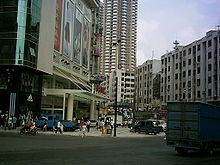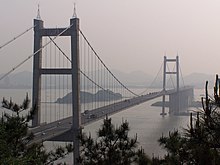Dongguan
City of Dongguan
东莞市 | |
|---|---|
| Country | China |
| Province | Guangdong |
| Government | |
| • CPC Committee Secretary | Tong Xing (佟星) |
| • Mayor | Liu Zhigeng (刘志庚) |
| Area | |
| • Total | 2,465 km2 (952 sq mi) |
| Population | |
| • Total | 6,445,700 |
| • Density | 2,600/km2 (6,800/sq mi) |
| Time zone | UTC+8 (China Standard Time) |
| Postal code | 523000 |
| Area code | 769 |
| License plate prefixes | 粤S |
| - Total | ¥ 315.1 billion (2007) |
| - Per capita | ¥ 46,014 (2007) |
| City flower | Yulan magnolia Magnolia denudata |
| Website | [1] (Chinese) |
Dongguan (simplified Chinese: 东莞; traditional Chinese: 東莞; pinyin: Dōngguǎn, Cantonese: Dung1 gun2; old spelling Tung-kuan) is a prefecture-level city in central Guangdong province, People's Republic of China. An important industrial city located in the Pearl River Delta, Dongguan borders the provincial capital of Guangzhou to the north, Huizhou to the northeast, Shenzhen to the south, and the Pearl River to the west. It is also home to the world's largest shopping mall, South China Mall. City administration is considered especially progressive in seeking foreign direct investment (see below). The three neighboring municipalities of Guangzhou, Dongguan, and Shenzhen are home to over 25 million residents, accounting for a large proportion of the Pearl River Delta's population. [1]
Administration
The prefecture-level city of Dongguan administers 3 county-level divisions, all of which are districts.
- Dongcheng District (东城区)
- Wanjiang District (万江区)
- Nancheng District (南城区)
The city government also directly administers the following 25 towns.
- Mayong Town (麻涌镇)
- Shilong Town (石龙镇)
- Humen Town (虎门镇)
- Daojiao Town (道滘镇)
- Shijie Town (石碣镇)
- Hongmei Town (洪梅镇)
- Liaobu Town (寮步镇)
- Dalingshan Town (大岭山镇)
- Dalang Town (大朗镇)

Town centre of Zhangmutou, Dongguan - Huangjiang Town (黄江镇)
- Zhangmutou Town (樟木头镇)
- Fenggang Town (凤岗镇)
- Tangxia Town (塘厦镇)
- Qingxi Town (清溪镇)
- Changping Town (常平镇)
- Qiaotou Town (桥头镇)
- Hengli Town (横沥镇)
- Dongkeng Town (东坑镇)
- Qishi Town (企石镇)
- Shipai Town (石排镇)
- Chashan Town (茶山镇)
- Chang'an Town (长安镇)
- Gaobu Town (高埗镇)
- Shatian Town (沙田镇)
- Wangniudun Town (望牛墩镇)
- Xiegang Town (谢岗镇)
- Zhongtang Town (中堂镇)
- Houjie Town (厚街镇)
Geography and climate

The urban center of Dongguan is 50 km away from that of Guangzhou to its north, 90 km away from Shenzhen to its south, 47 sea miles away from Hong Kong and 48 sea miles from Macau by waterway. Dongguan is a must-pass-by locality from Guangzhou to Hong Kong by road or waterway.Of the total area of Dongguan, 27% is water, 25% forest land, and 13% plow land, while 35% of its land area has been fully developed.
The climate of Dongguan is subtropical. It lies south of the Tropics of Cancer. The average temperature is 22.8°C throughout the year. The average rainfall is 1,756.8 millimeters. [2]
Demographics
Dongguan had 6,947,200 inhabitants at the end of 2007, and of these, approximately 70% are female. Many of the city's residents are migrant female workers who have come from distant provinces to work as factory girls.[3]
Dongguan is also a known hometown for many overseas Chinese, the root for over 700,000 people in Hong Kong, Taiwan and Macau and over 200,000 nationals living abroad.
Travel and transport

Many foreign travelers to Dongguan fly into Hong Kong, which allows visa-free entry to holders of US, Canadian and most European passports. After landing, visitors may apply for a visa to enter the rest of China. US Passport holders need a China Entry Visa to proceed to any location in Mainland China.
One can travel from Hong Kong to Dongguan by bus, ferry, or train. Passengers travelling overland must disembark from their transport at the Hong Kong/China border to go through customs and immigration, except for those traveling on the Mass Transit Railway intercity services (former Kowloon-Canton Railway) from Hung Hom Station to Dongguan, Guangzhou and beyond.
Depending on the time of day, using the ferry may be the most convenient way to travel from Hong Kong, as it allows one to avoid long queues at the land border checkpoint between Hong Kong and mainland China.
Rail services in and out of the city call at Dongguan railway station where there are direct train services to Guangzhou East railway station in Guangzhou; and Hung Hom Railway station in Hong Kong.
The Humen Pearl River Bridge is a suspension bridge over the Pearl River. Completed in 1997, it has a main span of 888 m.
Industry and commerce

City administration is considered especially progressive in seeking foreign direct investment. In 2005, the city hosted the first-ever Sino-American Forum of Intellectual Property Rights, co-organized by the Patent Protection Association of China - PPAC and the International Association for Technology Trade - IATT as well as what has been identified as the world's largest educational technology conference and expo, co-organized by IATT and the International Society for Technology in Education - ISTE, attracting nearly 40,000 attendees in its first year.
The Dongguan Science & Technology Museum (opened in December 2005), the high tech commerce park in the SongShan Lake district (which debuted in 2003) and a partnership with the Global IT Academy of the Brea Olinda Unified School District in Southern California have demonstrated the city's emphasis on attracting technology business. The city also announced in 2005 a planned investment of US$500-Million over five years for technology infrastructure improvements.
The city and province have been the recent focus of press and journalist attention with coverage of the arrival of teenaged Chinese workers, principally females (so-called factory girls), from agricultural areas to work in the area's factories and manufacturing/assembly facilities, where many are housed in large domitories, usually several to a room. [4]
While the city is the third largest exporting region in China, behind Shanghai and Shenzhen (and a major center for Taiwanese investment), outside of China, Dongguan has yet to gain the kind of name recognition realized by Shenzhen (just an hour away, and down-river from Dongguan). This may be because the city has placed an emphasis on investing in infrastructure, rather than directly targeting major corporations with financial incentives for economic development. Still, Dongguan has been identified by high level representatives of the National Development and Reform Commission of the central government as being one of the most significant growth regions for technology in the coming years.
Sister Cities
 Hartford, Connecticut, United States since (March 5, 2001) [5]
Hartford, Connecticut, United States since (March 5, 2001) [5] Thessaloniki, Greece since (October 24, 2008) [6]
Thessaloniki, Greece since (October 24, 2008) [6]
References
- ^ http://liveable.dg.gov.cn/about/default.htm
- ^ http://liveable.dg.gov.cn/about/natural.htm
- ^ Chang, Leslie T., Factory Girls: From Village to City In A Changing China, New York: Random House (2008), ISBN 9780385520171
- ^ Chang, Leslie T., Factory Girls: From Village to City In A Changing China, New York: Random House (2008), ISBN 9780385520171
- ^ "Donguan Forges Sister-city Relations With Hartford". People's Daily. Retrieved 2008-10-27.
- ^ "Dongguan and Thessaloniki Formed Sisterhood (in Chinese)". City of Dongguan. Retrieved 2008-10-27.
- Economic data
See also
- Guangdong Southern Tigers
- Lanwa FC plays in the Hong Kong, not Chinese, football pyramid
- Dongguan New Century


